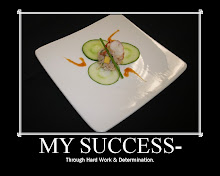As I read the links on Harold McGee’s newest articles the one titled “THE CURIOUS COOK, Prolonging the Life of Berries” REALLY stood out. Being the leader in my kitchen at work, I am always looking to cut my food costs with out sacrificing quality or my employees’ well being.
As I sat and began to read the first few lines of his article on berry preservation I was intrigued. Then my curiosity made me hop out of my seat and go grab a pack of berries out of my walk-in. “Does it really work?” I was consistently asking myself during my 45 sec trip to the walk-in.
Once I arrived to the walk-in I began to forage through every pack of berries. I had thought “WOW how ironic! This is the only time in my career where I am doing the complete opposite of what I normally do.” For once I had to look for the worst looking pack, not the best. A standard in the foodservice industry is to take the best-looking berries and use them in raw states. Then usually you take the overripe ones and turn them into compote, or bake them into pastries or make them into a batch of berry coulis.
In Harold McGee’s article he discussed such a simple yet logical solution to my question. Cutting cost sometimes doesn’t require ordering different product, sometimes its just how you apply what you have. I tend to order 1.5 times as much as I need for work. This in the culinary world is known as ordering by “edible yield percent.”
When ordering you traditionally tally what you need and order more due to non-edible waste. So in turn your food cost goes up. An example of this is if your recipe calls for eight ounces of romaine lettuce and a head of it weights ten ounces you will have just enough. So once you remove the inedible high cellulose core and the bruised outer three to four leaves you are left with 80 percent of the starting weight.
When dealing with highly perishable foods chefs tend to be able to use 100 percent of a berry but not 100 percent of the ordered product. In turn they end up with a mass of overripe berries.
These overripe berries end up leading to the chef searching for ways to use them up, practically giving them away. Utilizing McGee’s process I can order less, stop handing out as much and waste less. The whole problem with raw berries is two basic well-known issues.
The first one is the most obvious one to many chefs and it is taught at the base of many culinary programs, acetylene gas.
As some fruits sit they release their own reserve of acetylene gas. This gas will speed up their ripening process if in high concentration. If you leave a banana in a bag the acetylene gas builds up and will ripen the banana at an extremely accelerated rate. This is true with the berries in our experiment.
Second half to the problem is lead by the surface area’s bacterium and molds. The cause of decay and rot and can happen at an accelerated rate due to bacterium and mold. Mold spores are easily found everywhere, and the moisture exhaling fruits create a breading ground for them.
Along with the thin skin of many fruits it tends to lead to the rapid and easy penetration of the molds into the nutrient rich inner-flesh.
Mcgee’s preservation process is called Thermotherapy, which basically a very hot fruit bath.
This bath allows the gentle berries and fruit to maintain their raw unprocessed states with out sacrificing much. The minimal sacrifice is some nutrient loss in the thermotherapy bath.
In my experiment I took three pints of blueberries and poured them out on to a sheet pan and separated the molded or bruised ones.
Then I evenly divided the healthy ones into three groups. Then I heated one batch in 140°F water for 30 seconds. After I emptied the sample onto towels to cool down and dry, just as McGee had done. Then I took the second group of berries and “washed” them under plan cold tap water. Finally, I left the third batch of berries alone, as my control group. I did this just as i was taught by Dr. Eaton while doing scientific food based experiments in Food Science.
Once all three were processed I took three brand new airtight deli containers and placed the samples in them. The containers were clearly marked with their lids and all . Then stored on the counter top to accelerate the results. I came to realize at that point my patience would have to hold me over until the next day.
Twenty-four hours later I came back to discover that the project did result in the same out come that I had predicted. The thermotherapy treated batch had zero moldy blueberries. Meanwhile the washed batch had only three moldy berries. Finally the controlled unprocessed blueberries only had eight moldy berries.
McGee’s Blueberry experiment concluded with these results…
Out of a batch of 150 thermotherapy treated berries 2 moldy berries resulted.
Out of a batch of 150 non-thermotherapy treated berries 20 moldy berries resulted.
McGee also asked, “Why is it that delicate berries can survive heat high enough to kill mold and injure fingers? Probably because they have to do so in the field. One study of tomatoes found that intense sunlight raised their interiors to 122 degrees.”
I would like to know if that one is also true. I guess I will have to wait until my tomato plans have some maters on them this summer to find out. So, until the next page enjoy your food and CHEERS!
Jason Sokolowski C.C.
Chefsoko@aim.com
Sunday, May 15, 2011
Subscribe to:
Posts (Atom)
